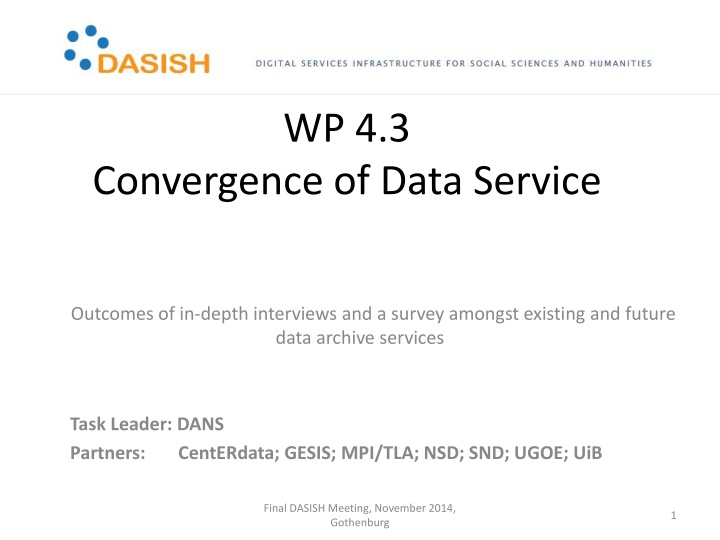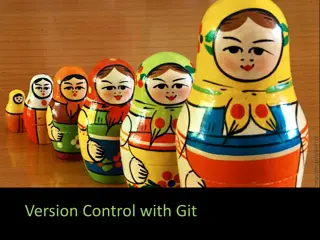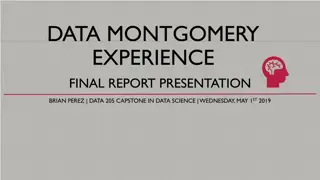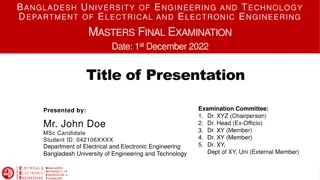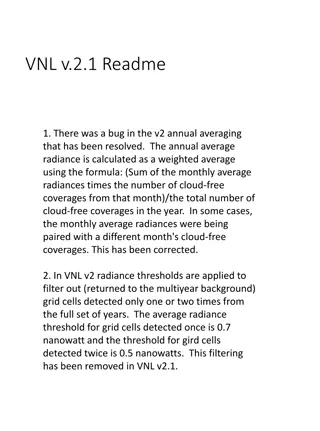Convergence of Data Service Outcomes in Data Archive Services
The study conducted in-depth interviews and a survey among existing and future data archive services to analyze the convergence of data service outcomes. The task aimed to select and promote high-quality deposit services and provide suggestions for service improvement based on the survey findings. The methodology included a survey in autumn/winter 2013 and in-depth interviews with Data Archive Services in summer 2014. The response overview and regional representation of responders, along with ESFRI representation, were discussed, highlighting funding sources for data archive services.
Download Presentation

Please find below an Image/Link to download the presentation.
The content on the website is provided AS IS for your information and personal use only. It may not be sold, licensed, or shared on other websites without obtaining consent from the author.If you encounter any issues during the download, it is possible that the publisher has removed the file from their server.
You are allowed to download the files provided on this website for personal or commercial use, subject to the condition that they are used lawfully. All files are the property of their respective owners.
The content on the website is provided AS IS for your information and personal use only. It may not be sold, licensed, or shared on other websites without obtaining consent from the author.
E N D
Presentation Transcript
WP 4.3 Convergence of Data Service Outcomes of in-depth interviews and a survey amongst existing and future data archive services Task Leader: DANS Partners: CentERdata; GESIS; MPI/TLA; NSD; SND; UGOE; UiB Final DASISH Meeting, November 2014, Gothenburg 1
Scope of Task according to the DoW - Select and promote a number of high-quality deposit services - Come with concrete suggestions for service improvement Final DASISH Meeting, November 2014, Gothenburg 2
Methodology - Survey autumn/winter 2013 - Building on the outcomes of Tasks 4.1 and 4.2 - In-depth interviews with Data Archive Services summer 2014 Final DASISH Meeting, November 2014, Gothenburg 3
Scope of Survey Gather information from organisations with relationship to CESSDA, CLARIN, DARIAH, ESS, or SHARE Questionnaire constructed, based on DADS (see Task 4.2) Transformed into web questionnaire by CentERdata Answered gathered between 20 September and 4 November 2013 Additional DADS derived from the survey outcomes Final DASISH Meeting, November 2014, Gothenburg 4
Response Overview Invitations sent: Complete responders: Partial responders: Non-responders: Non-archive responders: Double response: 89 46 (52 %) 5 ( 6 %) 33 (37 %) 3 ( 3%) 2 ( 2%) Final DASISH Meeting, November 2014, Gothenburg 5
Regional Representation (51 responders with a (future) DAS) Northwestern Europe: Eastern Europe: Southern Europe: 34 respondents 12 respondents 5 respondents Final DASISH Meeting, November 2014, Gothenburg 6
ESFRI Representation (full responders) CESSDA:24 respondents CLARIN: DARIAH: ESS: SHARE: (more than one representation per respondent possible) 22 respondents 13 respondents 7 respondents 6 respondents Co-relationships between CLARIN and DARIAH and between CESSDA and SHARE/ESS Final DASISH Meeting, November 2014, Gothenburg 7
Funding of Data Archive Services [N=51] (Partial) public funding With additional Third Party Funding With additional Revenues 48 20 10 Complete Third Party Funding (Partial) Project-Based Funding 1 4 (more than one type of funding possible per service) Final DASISH Meeting, November 2014, Gothenburg 8
Designated Communities: definition According to the OAIS-model: An identified group of potential consumers who should be able to understand a particular set of information Final DASISH Meeting, November 2014, Gothenburg 9
Designated Communities Social Scientists Linguists Historians Other, mostly multidisciplinary 18 21 9 3 Final DASISH Meeting, November 2014, Gothenburg 10
Organisational Aspects of Data Archive Services Availability of mission statement: Availability of deposit agreement: 36 (72 %) Availability of usage agreement: Availability of preservation policy: 26 (50 %) 34 (65 %) 35 (69 %) Final DASISH Meeting, November 2014, Gothenburg 11
Rights Management within Data Archive Services Transfer of non-exclusive rights No transfer of rights Depositor retains rights Other 26 (50 %) 3 ( 6 %) 13 (25 %) 9 ( 18 %) Final DASISH Meeting, November 2014, Gothenburg 12
Ingest: file formats Only deposit in accepted file formats Archive works with list of preferred formats 19 (38 %) Archive does not indicate restrictions Archive negotiates with depositor 5 (10 %) 17 (34 %) 8 (16 %) Final DASISH Meeting, November 2014, Gothenburg 13
Ingest: metadata formats DC DDI CMDI TEI IMDI Other 20 (40 %) 18 (36 %) 13 (26 %) 12 (24 %) 5 (10 %) 16 (32 %) Final DASISH Meeting, November 2014, Gothenburg 14
Preservation Strategy Migration Emulation Bitstream Other 28 (56 %) 2 ( 4 %) 18 (36 %) 13 (26 %) Final DASISH Meeting, November 2014, Gothenburg 15
Level of Trust Trustworthiness Strategy Preparatory Phase DSA DSA/Drambora self-assessment Peer-reviewed DSA Peer-reviewed ISO 16363 No strategy 6 (12 %) 8 (16 %) 9 (18 %) 1 ( 2 %) 22 (44 %) (yet) Note: level 1 and above-> NW Europe Final DASISH Meeting, November 2014, Gothenburg 16
Dissemination Ways of Accessing Archives Websites Online catalogues Special interfaces 29 (58 %) 24 (48 %) 7 (14 %) Final DASISH Meeting, November 2014, Gothenburg 17
Future Developments I Improvement of administration [documentation; data policy plans etc.] Improvement of ingest [automated ingest; submission agreement development; metadata standards] Storage & Preservation [preservation policy; provenance registration; PIDs] Gothenburg Final DASISH Meeting, November 2014, 18
Future Developments II Dissemination [Single Sign-On; user interface] Other items [certification; annotation tools; authentication and authorisation] Final DASISH Meeting, November 2014, Gothenburg 19
In-depth interviews Limited number of Data Archive Services Representing DARIAH, CESSDA and CLARIN Representing Northwest- and Eastern Europe Focus on upcoming services (existing DASs have been analysed in WP 4.2) Interviews conducted during spring/summer 2014 Final DASISH Meeting, November 2014, Gothenburg 20
Methodology Fixed set of mandatory questions in combinations with a limited set of additional set of additional questions Interviewers from UiB, SND, UGOE and DANS Interviewees from BAS, UFAL/LINDAT, TextGrid, DRI, DDA, and ADP Final DASISH Meeting, November 2014, Gothenburg 21
Technical infrastructure DASs Techniques used not uniform Functionalities offered quite similar Authentication and Authorisation major issues Final DASISH Meeting, November 2014, Gothenburg 22
Authentication and Authorisation Infrastructure DASs are free in choosing their AAI Risk on making silos of the various ESFRIs Development of Federated Identity Management for inter-ESFRI access Final DASISH Meeting, November 2014, Gothenburg 23
Cooperation in preservation Translate the US Data-Pass model European Digital Stewardship Alliance (EDSA) DASISH initiative? Final DASISH Meeting, November 2014, Gothenburg 24
PIDs PID-services for tracing datasets Making use of a PID-service is more important than the choice for a specific service Interoperability of the PID-services is crucial See PID-workshop in Cologne in December Final DASISH Meeting, November 2014, Gothenburg 25
Primary Designated Community Two distinguished communities: Community of Depositors Community of (re-)users of deposited datasets Only for the depositors a community may be defined Re-use of data may come to various disciplines, even the natural sciences Final DASISH Meeting, November 2014, Gothenburg 26
DASs requirements Minimum set of metadata for each dataset deposited Guarantee a minimum level of Trust: DSA Availability of deposit agreements Key focus: lack of access to data management guidelines (see also Task 4.4) Final DASISH Meeting, November 2014, Gothenburg 27
Working on Best Practices Willingness to implement guidelines and practices described in WP 4.2 Key issues: Mandatory deposit agreements Obligatory usage agreements Preservation on a higher level than just bitstream Improved training facilities Tailor-made approach is needed in setting up DASs Final DASISH Meeting, November 2014, Gothenburg 28
Relation with outcomes WP 4.1 Willingness to work on Trust DSA very popular (basic certification) DIN 31644/ISO 16363 seems to be a bridge too far Exception: DRI Final DASISH Meeting, November 2014, Gothenburg 29
Selecting High-Quality DASs Set of recommendations (requirements) defined in WP 4.2 hard to meet A number of DASs has made good progress A limited number of recommendations used in the selection process Final DASISH Meeting, November 2014, Gothenburg 30
Main selection criteria for high-quality DASs (as part of the DASs contacted for the questionnaire and the DADS in 4.2) Having met minimally the DSA criteria Availability of a preservation policy Clear deposit licences Clear usage licences Clear rights manegement Final DASISH Meeting, November 2014, Gothenburg 31
High-quality DASs: A. well-known DASs UKDA GESIS NSD DANS TLA CESSDA CESSDA CESSDA CESSDA, CLARIN, DARIAH CLARIN Final DASISH Meeting, November 2014, Gothenburg 32
High-quality DASs: B. Other high-potentials I ADS BAS CSDA Oxford Text Arch. UK RODA TextGrid UK Ger Czech DARIAH CLARIN; SHARE CESSDA; ESS CLARIN CESSDA DARIAH Rom. Ger Final DASISH Meeting, November 2014, Gothenburg 33
High-quality DASs: B. Other high-potentials II St. Beeld & Geluid NL UFAL DDA DTARe CLARIN CLARIN CESSDA CLARIN Czech Denmark Ger Final DASISH Meeting, November 2014, Gothenburg 34
Promising DAS CESSDA ADP Slov. No DSA yet DARIS Swi CESSDA/ESS/SHARE No DSA; policies not clear R seau Quetelet Fra CESSDA/ESS/SHARE No DSA yet SLDR Fra CLARIN; DARIAH No DSA yet Tarki Hun CESSDA; ESS No DSA yet DRI Eire CESSDA; DARIAH Fully functional in 2015 Final DASISH Meeting, November 2014, Gothenburg 35
Ideas for further service improvement I Use PID-systems (see also report 5.1B) Take concrete steps on the development of a Federated Identity Management System (see also report 5.1A) Create a European Digital Stewardship Alliance Exchange of training modules developed within the 5 ESFRIs Final DASISH Meeting, November 2014, Gothenburg 36
Ideas for further service improvement II Use certification tools both for assessing the quality of DASs as for the setting up of new DASs Harmonise deposit agreements, guidelines, procedures and requirements Final DASISH Meeting, November 2014, Gothenburg 37
Concluding remarks Only the combination of the DADs (from 4.2) and the survey/interviews has made it possible to come to a useful description of the deposit services landscape We would like to thank all the new and existing deposit services for their contributions Final DASISH Meeting, November 2014, Gothenburg 38
